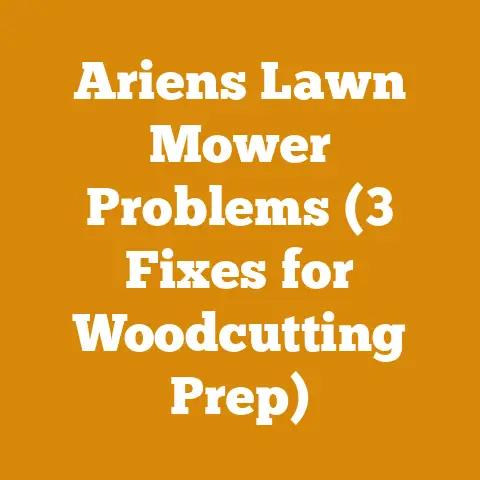Tree Survey Cost Explained (Mature Tree Health & Risk Insights)
Introduction
Tree Survey Cost Explained (Mature Tree Health & Risk Insights)
As someone who’s spent years felling, processing, and managing trees, I’ve seen firsthand the consequences of neglecting tree health. A seemingly healthy tree can harbor hidden dangers, posing risks to property and, more importantly, people. Let’s delve into the world of tree surveys and uncover the value they offer.
Why are Tree Surveys Important?
Tree surveys are essential for several reasons:
- Safety: Identifying hazardous trees that could fall and cause damage or injury.
- Property Value: Maintaining the health and appearance of trees to enhance property value.
- Legal Compliance: Fulfilling legal obligations to ensure tree safety, especially for landowners with public access.
- Tree Preservation: Developing informed management plans to protect and prolong the life of valuable trees.
- Insurance Requirements: Meeting insurance company requirements for tree risk assessments.
Types of Tree Surveys
There are several types of tree surveys, each tailored to specific needs and objectives:
- Number of Trees: The more trees that need to be assessed, the higher the cost.
- Tree Size and Complexity: Larger and more complex trees require more time and expertise to assess.
- Survey Type: Detailed surveys with advanced testing are more expensive than basic visual assessments.
- Location: Surveys in urban areas or difficult-to-access locations may incur higher costs.
- Arborist’s Experience and Qualifications: Experienced and certified arborists typically charge more for their services.
- Geographic Location: Costs can vary depending on the region, with metropolitan areas often having higher rates.
- Reporting Requirements: More detailed reports with maps and recommendations will increase the cost.
Average Tree Survey Costs
While costs can vary, here’s a general overview of average tree survey costs:
- Visual Tree Assessment (VTA): \$50 – \$150 per tree
- Basic Tree Survey: \$100 – \$300 per tree
- Detailed Tree Survey: \$300 – \$1000+ per tree
- Mortgage Tree Survey: \$200 – \$500
- Development Tree Survey: \$500 – \$2000+ (depending on the size of the development site)
- BS5837 Tree Survey: \$800 – \$5000+ (depending on the size and complexity of the site)
These are just estimates, and it’s always best to get a quote from a qualified arborist for your specific needs.
Breaking Down the Costs: A Detailed Look
To better understand the costs involved, let’s break down the components of a typical tree survey:
- Common Tree Diseases:
- Oak Wilt: A fungal disease that can kill oak trees quickly.
- Dutch Elm Disease: A fungal disease that affects elm trees.
- Apple Scab: A fungal disease that affects apple and crabapple trees.
- Anthracnose: A fungal disease that causes leaf spots and twig dieback.
- Root Rot: A fungal disease that affects the roots of trees, leading to decline and death.
- Common Tree Pests:
- Emerald Ash Borer: An invasive beetle that kills ash trees.
- Asian Longhorned Beetle: An invasive beetle that attacks a wide range of hardwood trees.
- Gypsy Moth: A defoliating insect that can strip trees of their leaves.
- Aphids: Small insects that suck sap from trees, causing leaf distortion and stunted growth.
- Scale Insects: Small, armored insects that feed on tree sap, causing leaf yellowing and twig dieback.
- Structural Defects:
- Cracks: Splits in the trunk or branches that can weaken the tree.
- Cavities: Hollow areas in the trunk or branches caused by decay.
- Included Bark: Bark that is trapped between two branches, creating a weak point.
- Weak Branch Unions: Branches that are poorly attached to the trunk, making them prone to failure.
- Leaning Trees: Trees that are leaning excessively, indicating potential root problems or structural weakness.
Risk Assessment: Identifying Potential Hazards
A key component of a tree survey is risk assessment, which involves evaluating the likelihood of a tree failure and the potential consequences.
- Risk Rating Systems: Arborists use various risk rating systems to assess the overall risk associated with a tree. These systems consider factors such as:
- Target: The people or property that could be affected by a tree failure.
- Size of Defect: The size and severity of any defects present in the tree.
- Likelihood of Failure: The probability that the tree will fail.
- Consequences of Failure: The potential damage or injury that could result from a tree failure.
- Hazard Mitigation: Based on the risk assessment, the arborist will recommend appropriate hazard mitigation measures, such as:
- Pruning: Removing dead, diseased, or hazardous branches to reduce the risk of failure.
- Cabling and Bracing: Installing cables or braces to support weak branches or stems.
- Tree Removal: Removing trees that are deemed too hazardous to retain.
- Root Pruning: Cutting roots to prevent damage to underground utilities or structures.
- Soil Amendments: Improving soil conditions to promote tree health and stability.
The Arborist’s Toolkit: Tools and Techniques Used in Tree Surveys
Arborists use a variety of tools and techniques to assess tree health and structural integrity:
- Key Components of the Report:
- Tree Inventory: A list of all the trees surveyed, including their species, size, and location.
- Condition Assessment: A detailed description of the health and structural condition of each tree.
- Risk Assessment: An evaluation of the potential risks associated with each tree.
- Recommendations: Specific recommendations for tree management, such as pruning, cabling, or removal.
- Photographs: Photographs of the trees and any defects or hazards identified.
- Maps: Maps showing the location of the trees and any areas of concern.
- Interpreting the Report:
- Pay close attention to the arborist’s recommendations and prioritize actions based on the level of risk.
- Ask the arborist to explain any terms or concepts that you don’t understand.
- Consider getting a second opinion if you have any concerns about the arborist’s findings.
Case Studies: Real-World Examples of Tree Surveys in Action
To illustrate the value of tree surveys, let’s look at a few real-world examples:
- Case Study 1: Preventing Property Damage
- A homeowner hired an arborist to conduct a tree survey on their property. The survey revealed that a large oak tree near the house had a significant cavity in its trunk and was at risk of falling. The arborist recommended removing the tree, which the homeowner did. A few months later, a severe storm hit the area, and several trees fell. The oak tree that had been removed would have fallen on the house, causing significant damage.
- Case Study 2: Identifying Hidden Hazards
- A property manager hired an arborist to conduct a tree survey on a commercial property. The survey revealed that several trees had root rot, a disease that weakens the roots and makes the trees prone to falling. The property manager had the trees removed, preventing potential injuries to employees and customers.
- Case Study 3: Preserving Valuable Trees
- A city hired an arborist to conduct a tree survey in a park. The survey revealed that several mature trees were suffering from nutrient deficiencies. The arborist recommended a fertilization program, which helped to improve the health and vigor of the trees. The city was able to preserve these valuable trees for future generations.
Common Mistakes to Avoid When Hiring an Arborist
Hiring the right arborist is crucial for getting accurate and reliable tree survey results. Here are some common mistakes to avoid:
- Not Checking Credentials: Make sure the arborist is certified by the International Society of Arboriculture (ISA) or a similar organization.
- Not Getting Multiple Quotes: Get quotes from several arborists to compare prices and services.
- Not Asking for References: Ask for references from previous clients to check the arborist’s reputation.
- Not Understanding the Scope of Work: Make sure you understand what the arborist will be doing and what you will receive in the report.
- Not Asking Questions: Don’t hesitate to ask the arborist questions about their experience, qualifications, and methods.
- Choosing Based on Price Alone: The cheapest arborist may not be the best choice. Consider the arborist’s experience, qualifications, and reputation.
Safety Considerations During Tree Surveys
Tree surveys can be hazardous, especially when working with large trees or in difficult-to-access locations. Arborists must follow strict safety procedures to protect themselves and others.
- Personal Protective Equipment (PPE): Arborists should wear appropriate PPE, such as hard hats, safety glasses, gloves, and sturdy boots.
- Traffic Control: When working near roads or sidewalks, arborists should use traffic control measures to protect pedestrians and vehicles.
- Electrical Hazards: Arborists should be aware of electrical hazards, such as overhead power lines, and take precautions to avoid contact.
- Climbing Safety: When climbing trees, arborists should use proper climbing techniques and equipment, such as ropes, harnesses, and lanyards.
- Emergency Procedures: Arborists should have a plan in place for dealing with emergencies, such as falls or injuries.
The Future of Tree Surveys: Emerging Technologies and Trends
The field of tree surveys is constantly evolving, with new technologies and techniques emerging all the time.
- Drones: Drones equipped with cameras and sensors are becoming increasingly popular for tree surveys, allowing arborists to inspect trees from a distance and gather data more efficiently.
- LiDAR: LiDAR (Light Detection and Ranging) technology uses laser scanners to create detailed 3D models of trees and forests, providing valuable information for tree management.
- Artificial Intelligence (AI): AI is being used to analyze tree survey data and identify potential hazards more quickly and accurately.
- Remote Sensing: Remote sensing technologies, such as satellite imagery, are being used to monitor tree health and detect forest disturbances on a large scale.
- Mobile Apps: Mobile apps are being developed to help arborists collect and manage tree survey data in the field.
Tree Survey Costs: A Global Perspective
Tree survey costs can vary significantly depending on the country or region. Factors such as labor costs, regulations, and the availability of qualified arborists can all influence prices.
- United States: Tree survey costs in the United States are generally in line with the averages provided earlier in this guide. However, costs can vary depending on the state and city.
- United Kingdom: Tree survey costs in the United Kingdom are often higher than in the United States, due to stricter regulations and higher labor costs.
- Canada: Tree survey costs in Canada are similar to those in the United States, but may be higher in remote areas.
- Australia: Tree survey costs in Australia can be high, due to the country’s vast size and the limited number of qualified arborists.
- Europe: Tree survey costs in Europe vary depending on the country, with costs generally being higher in Western Europe than in Eastern Europe.
DIY Tree Assessment vs. Professional Tree Survey
While it may be tempting to conduct your own tree assessment to save money, it’s generally not recommended, especially for mature trees. A qualified arborist has the knowledge, experience, and tools to identify potential hazards that you might miss.
- DIY Tree Assessment:
- Pros: Cost-effective, can identify obvious problems.
- Cons: Limited knowledge, lack of specialized tools, potential for misdiagnosis.
- Professional Tree Survey:
- Pros: Accurate assessment, identification of hidden hazards, expert recommendations.
- Cons: More expensive, requires hiring a qualified arborist.
Negotiating Tree Survey Costs
While tree surveys are an important investment, it’s always a good idea to negotiate the price if possible. Here are some tips for negotiating tree survey costs:
- Get Multiple Quotes: Compare prices from several arborists and use the quotes to negotiate a better price.
- Ask for a Discount: Ask the arborist if they offer any discounts, such as for multiple trees or for being a repeat customer.
- Negotiate the Scope of Work: If you don’t need a detailed report, you may be able to negotiate a lower price by reducing the scope of work.
- Pay in Cash: Some arborists may offer a discount for cash payments.
- Schedule During Off-Peak Season: Arborists may be more willing to negotiate prices during their off-peak season.
Tree Survey Checklist: What to Expect
To ensure a smooth and successful tree survey, here’s a checklist of what to expect:
- Before the Survey:
- Hire a qualified arborist.
- Get a written quote and contract.
- Communicate your concerns and objectives to the arborist.
- During the Survey:
- Allow the arborist access to all areas of the property.
- Answer any questions the arborist may have.
- Observe the arborist’s work and ask questions if needed.
- After the Survey:
- Review the arborist’s report carefully.
- Discuss the recommendations with the arborist.
- Implement the recommended tree management practices.
- Schedule follow-up surveys as needed.
Tree Surveys and Insurance Claims
Tree surveys can be helpful when making insurance claims for tree-related damage. If a tree falls and damages your property, your insurance company may require a tree survey to assess the cause of the failure and determine liability.
- Documentation: Provide the insurance company with a copy of the tree survey report and any other relevant documentation, such as photographs and repair estimates.
- Expert Testimony: The arborist who conducted the tree survey may be called upon to provide expert testimony in support of your claim.
- Liability: The insurance company will determine liability based on the findings of the tree survey and other evidence. If the tree failure was caused by negligence, such as failure to maintain the tree properly, the responsible party may be liable for the damages.
Maintaining Tree Health After a Survey
A tree survey is just the first step in ensuring the health and safety of your trees. It’s important to follow the arborist’s recommendations and implement a regular tree maintenance program.
- Pruning: Prune trees regularly to remove dead, diseased, or hazardous branches.
- Fertilization: Fertilize trees as needed to provide them with the nutrients they need to thrive.
- Watering: Water trees during dry periods to prevent stress.
- Mulching: Apply mulch around the base of trees to conserve moisture, suppress weeds, and improve soil health.
- Pest and Disease Control: Monitor trees for signs of pests and diseases and take appropriate action to control them.
- Regular Inspections: Conduct regular visual inspections of your trees to identify any new problems or hazards.
Resources for Learning More About Tree Care
There are many resources available to help you learn more about tree care and management:
- International Society of Arboriculture (ISA): The ISA is a professional organization for arborists that provides certification, education, and research.
- Arbor Day Foundation: The Arbor Day Foundation is a non-profit organization that promotes tree planting and conservation.
- Local Extension Services: Your local extension service can provide information and advice on tree care and management.
- Online Resources: There are many websites and online forums dedicated to tree care and management.
Tree Survey Cost: Is It Worth It?
While tree surveys can be an added expense, the benefits they provide often outweigh the costs. By identifying potential hazards and implementing appropriate management practices, you can protect your property, ensure the safety of people, and preserve the value of your trees.
- Benefits of Tree Surveys:
- Improved Safety
- Enhanced Property Value
- Legal Compliance
- Tree Preservation
- Informed Decision-Making
- When to Consider a Tree Survey:
- Mature Trees on Your Property
- Trees Near Buildings or Utilities
- Trees with Signs of Disease or Damage
- Before Construction or Development
- When Required by Insurance or Local Regulations
Conclusion: Investing in Tree Health and Safety
As someone who has worked with trees for years, I can tell you that they are a valuable asset that deserves our care and attention. Investing in tree surveys is an investment in the health, safety, and longevity of your trees. By understanding the costs and benefits of tree surveys, you can make informed decisions about tree management and protect your property and loved ones from potential hazards. Don’t wait until a tree falls and causes damage or injury. Take proactive steps to assess the health and risk of your trees and ensure their continued well-being. It’s an investment that will pay off in the long run.






